Adam & Co Case Study: Evaluating Expenditure Cycle Systems and Risks
VerifiedAdded on 2022/11/01
|17
|3385
|55
Case Study
AI Summary
This report presents a comprehensive analysis of Adam & Co's expenditure cycle, focusing on its purchase, cash disbursement, and payroll systems. It utilizes data flow diagrams and system flowcharts to illustrate the processes within each system. The study delves into the potential risks and weaknesses inherent in these systems, providing a detailed examination of internal control deficiencies. The report aims to assist the Chief Operating Officer (COO) in assessing the risks, processes, and internal controls within Adam & Co's expenditure cycle, offering insights into potential areas for improvement and risk mitigation. The case study covers key aspects such as inventory management, vendor relations, and financial transaction processing.
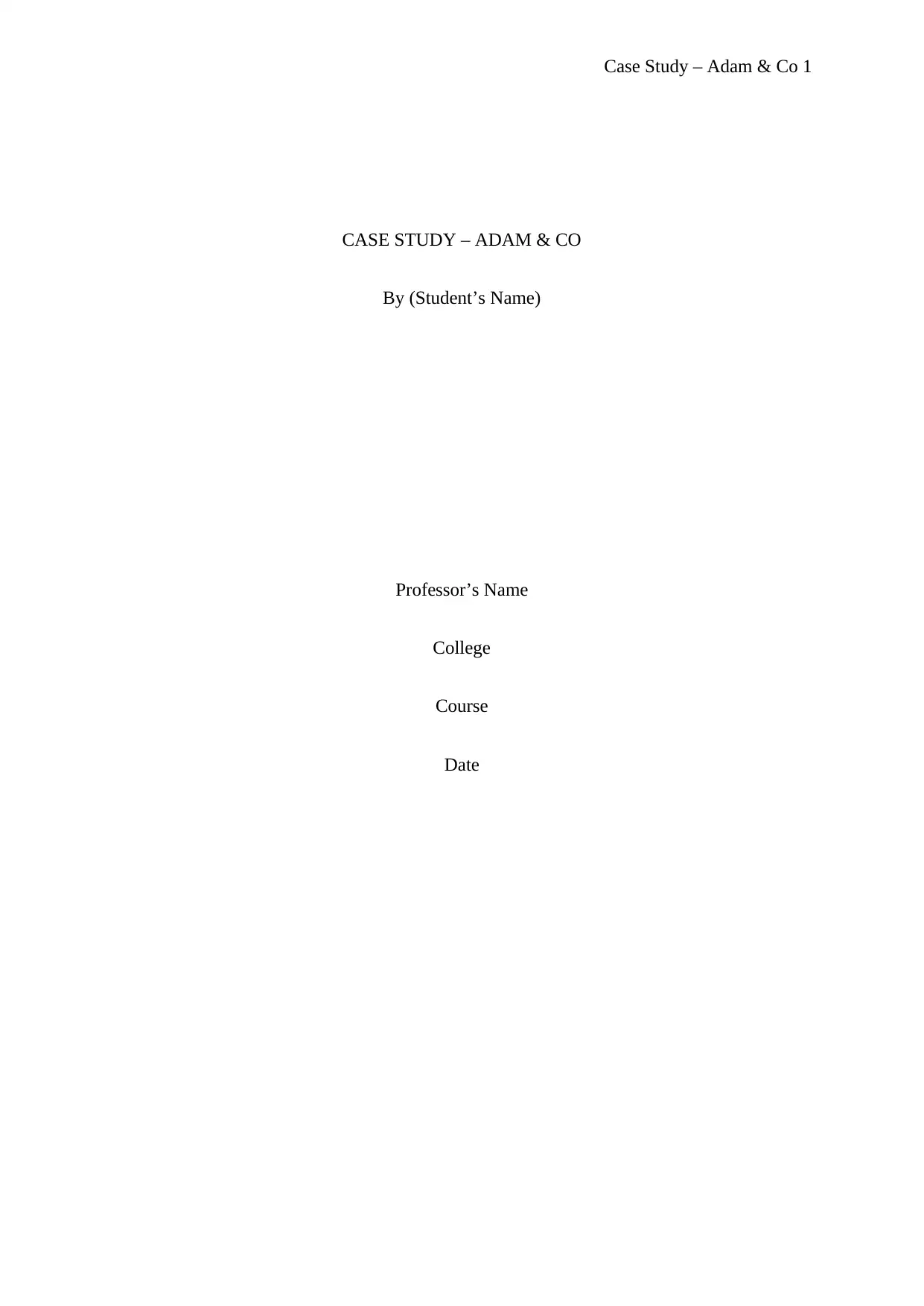
Case Study – Adam & Co 1
CASE STUDY – ADAM & CO
By (Student’s Name)
Professor’s Name
College
Course
Date
CASE STUDY – ADAM & CO
By (Student’s Name)
Professor’s Name
College
Course
Date
Paraphrase This Document
Need a fresh take? Get an instant paraphrase of this document with our AI Paraphraser
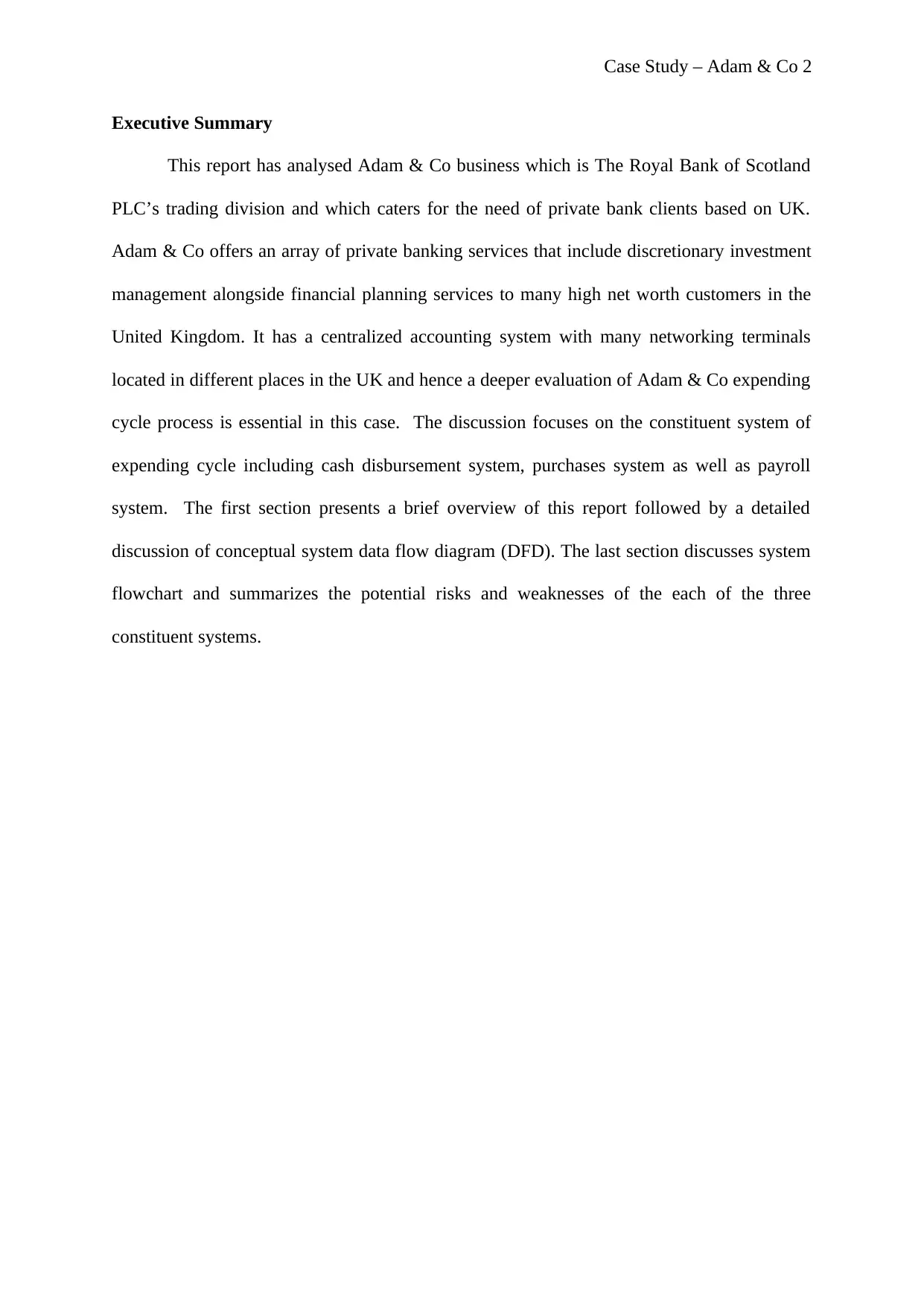
Case Study – Adam & Co 2
Executive Summary
This report has analysed Adam & Co business which is The Royal Bank of Scotland
PLC’s trading division and which caters for the need of private bank clients based on UK.
Adam & Co offers an array of private banking services that include discretionary investment
management alongside financial planning services to many high net worth customers in the
United Kingdom. It has a centralized accounting system with many networking terminals
located in different places in the UK and hence a deeper evaluation of Adam & Co expending
cycle process is essential in this case. The discussion focuses on the constituent system of
expending cycle including cash disbursement system, purchases system as well as payroll
system. The first section presents a brief overview of this report followed by a detailed
discussion of conceptual system data flow diagram (DFD). The last section discusses system
flowchart and summarizes the potential risks and weaknesses of the each of the three
constituent systems.
Executive Summary
This report has analysed Adam & Co business which is The Royal Bank of Scotland
PLC’s trading division and which caters for the need of private bank clients based on UK.
Adam & Co offers an array of private banking services that include discretionary investment
management alongside financial planning services to many high net worth customers in the
United Kingdom. It has a centralized accounting system with many networking terminals
located in different places in the UK and hence a deeper evaluation of Adam & Co expending
cycle process is essential in this case. The discussion focuses on the constituent system of
expending cycle including cash disbursement system, purchases system as well as payroll
system. The first section presents a brief overview of this report followed by a detailed
discussion of conceptual system data flow diagram (DFD). The last section discusses system
flowchart and summarizes the potential risks and weaknesses of the each of the three
constituent systems.
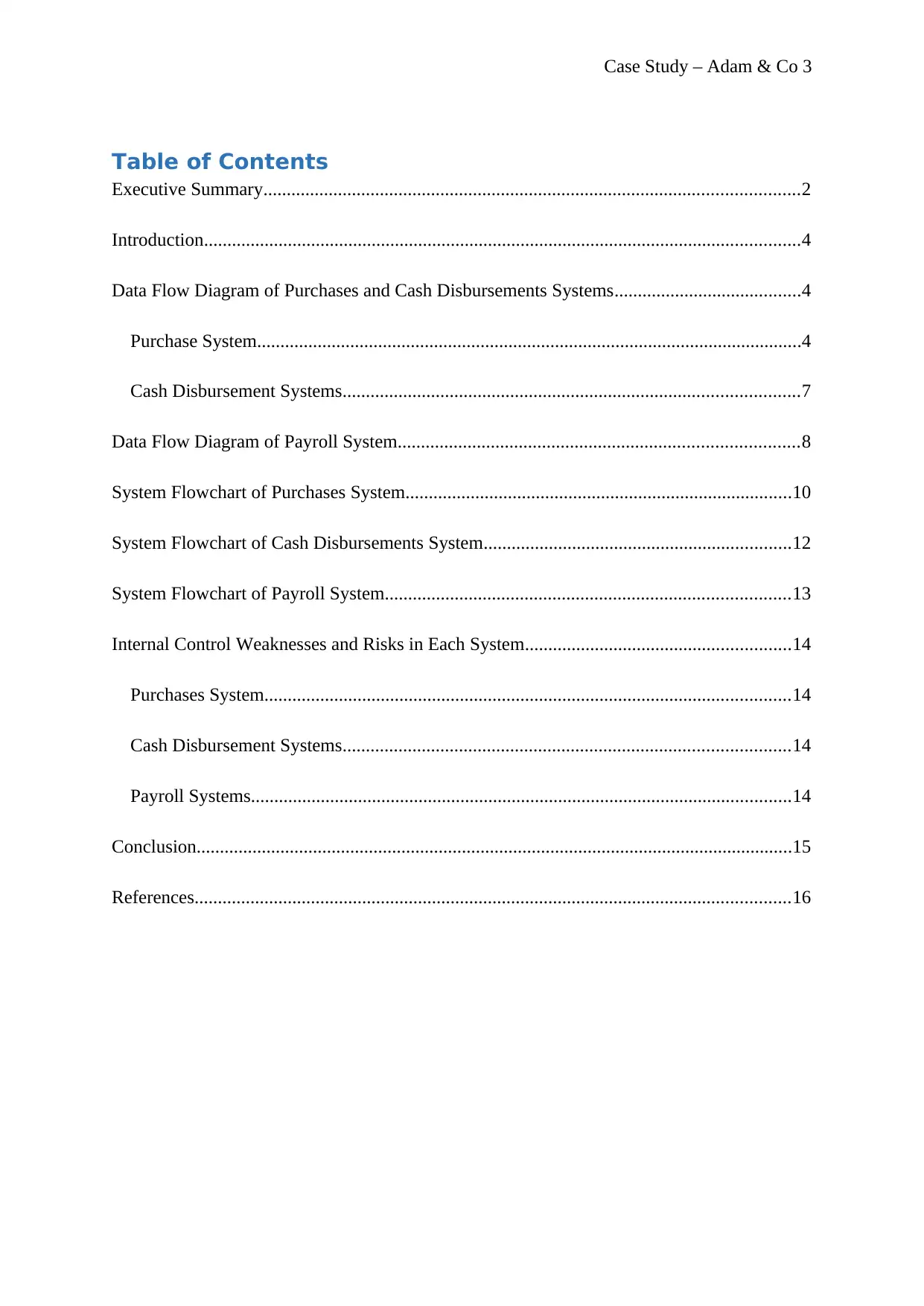
Case Study – Adam & Co 3
Table of Contents
Executive Summary...................................................................................................................2
Introduction................................................................................................................................4
Data Flow Diagram of Purchases and Cash Disbursements Systems........................................4
Purchase System.....................................................................................................................4
Cash Disbursement Systems..................................................................................................7
Data Flow Diagram of Payroll System......................................................................................8
System Flowchart of Purchases System...................................................................................10
System Flowchart of Cash Disbursements System..................................................................12
System Flowchart of Payroll System.......................................................................................13
Internal Control Weaknesses and Risks in Each System.........................................................14
Purchases System.................................................................................................................14
Cash Disbursement Systems................................................................................................14
Payroll Systems....................................................................................................................14
Conclusion................................................................................................................................15
References................................................................................................................................16
Table of Contents
Executive Summary...................................................................................................................2
Introduction................................................................................................................................4
Data Flow Diagram of Purchases and Cash Disbursements Systems........................................4
Purchase System.....................................................................................................................4
Cash Disbursement Systems..................................................................................................7
Data Flow Diagram of Payroll System......................................................................................8
System Flowchart of Purchases System...................................................................................10
System Flowchart of Cash Disbursements System..................................................................12
System Flowchart of Payroll System.......................................................................................13
Internal Control Weaknesses and Risks in Each System.........................................................14
Purchases System.................................................................................................................14
Cash Disbursement Systems................................................................................................14
Payroll Systems....................................................................................................................14
Conclusion................................................................................................................................15
References................................................................................................................................16
⊘ This is a preview!⊘
Do you want full access?
Subscribe today to unlock all pages.

Trusted by 1+ million students worldwide

Purchasing
Department
Inventory
Warehous
e
Cash
Disbursement
Department
Monitor inventory
records
Updates inventory
records
Receives Goods
Prepares Digital
Purchase Order
Updates Inventory
Control Access
Updates AP Control
Access
Updates digital AP
subsidiary ledger
Valid Vendor File
AP Pending File
Vendor
Account
Payable
Department
Inventory Subsidiary Ledger
Receiving File
Digital purchase order records
Purchase order copy 1
Purchase order copy 2
Receiving reports copy
Receiving report copy 2
Sends invoice
Sends invoice
Inventory level
Case Study – Adam & Co 4
Introduction
The major expenditure cycle’s spending is to allow the physical materials, human
resources and business cash’s conversion which enhance several organizational functions.
This report is an analysis of expending cycle including purchases system, cash-disbursement
system and payroll system in Adam & Co. This includes evaluating pertinent risks and
weaknesses of the systems to allow the Chief Operating Officer (COO) of Adam & Co to
assess the risks, processes alongside internal control of the firm’s expenditure cycle.
Data Flow Diagram of Purchases and Cash Disbursements Systems
Purchase System
Figure 1: Purchase System Data Flow Diagram
Inventory
Subsidiary
Ledger
Department
Inventory
Warehous
e
Cash
Disbursement
Department
Monitor inventory
records
Updates inventory
records
Receives Goods
Prepares Digital
Purchase Order
Updates Inventory
Control Access
Updates AP Control
Access
Updates digital AP
subsidiary ledger
Valid Vendor File
AP Pending File
Vendor
Account
Payable
Department
Inventory Subsidiary Ledger
Receiving File
Digital purchase order records
Purchase order copy 1
Purchase order copy 2
Receiving reports copy
Receiving report copy 2
Sends invoice
Sends invoice
Inventory level
Case Study – Adam & Co 4
Introduction
The major expenditure cycle’s spending is to allow the physical materials, human
resources and business cash’s conversion which enhance several organizational functions.
This report is an analysis of expending cycle including purchases system, cash-disbursement
system and payroll system in Adam & Co. This includes evaluating pertinent risks and
weaknesses of the systems to allow the Chief Operating Officer (COO) of Adam & Co to
assess the risks, processes alongside internal control of the firm’s expenditure cycle.
Data Flow Diagram of Purchases and Cash Disbursements Systems
Purchase System
Figure 1: Purchase System Data Flow Diagram
Inventory
Subsidiary
Ledger
Paraphrase This Document
Need a fresh take? Get an instant paraphrase of this document with our AI Paraphraser
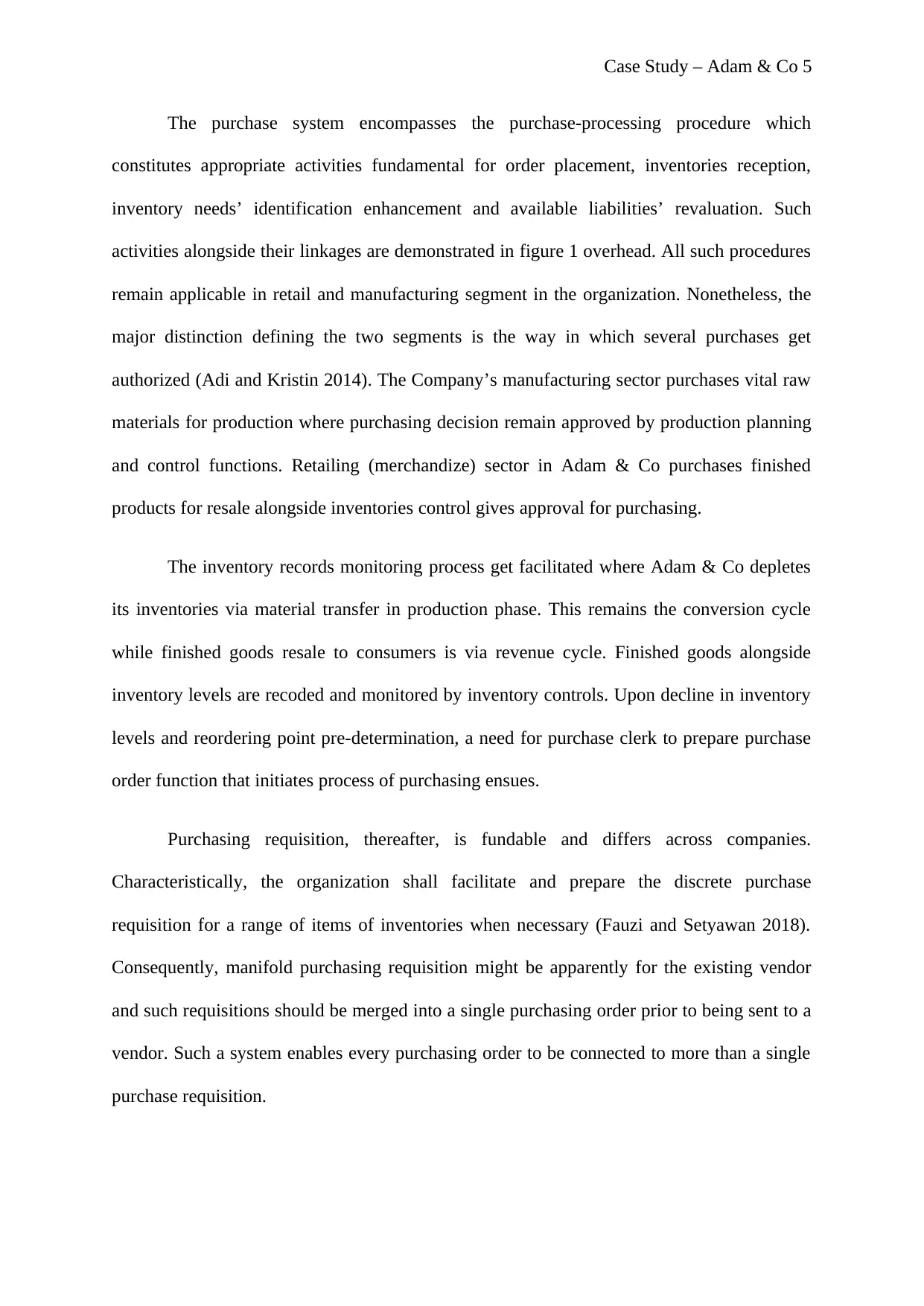
Case Study – Adam & Co 5
The purchase system encompasses the purchase-processing procedure which
constitutes appropriate activities fundamental for order placement, inventories reception,
inventory needs’ identification enhancement and available liabilities’ revaluation. Such
activities alongside their linkages are demonstrated in figure 1 overhead. All such procedures
remain applicable in retail and manufacturing segment in the organization. Nonetheless, the
major distinction defining the two segments is the way in which several purchases get
authorized (Adi and Kristin 2014). The Company’s manufacturing sector purchases vital raw
materials for production where purchasing decision remain approved by production planning
and control functions. Retailing (merchandize) sector in Adam & Co purchases finished
products for resale alongside inventories control gives approval for purchasing.
The inventory records monitoring process get facilitated where Adam & Co depletes
its inventories via material transfer in production phase. This remains the conversion cycle
while finished goods resale to consumers is via revenue cycle. Finished goods alongside
inventory levels are recoded and monitored by inventory controls. Upon decline in inventory
levels and reordering point pre-determination, a need for purchase clerk to prepare purchase
order function that initiates process of purchasing ensues.
Purchasing requisition, thereafter, is fundable and differs across companies.
Characteristically, the organization shall facilitate and prepare the discrete purchase
requisition for a range of items of inventories when necessary (Fauzi and Setyawan 2018).
Consequently, manifold purchasing requisition might be apparently for the existing vendor
and such requisitions should be merged into a single purchasing order prior to being sent to a
vendor. Such a system enables every purchasing order to be connected to more than a single
purchase requisition.
The purchase system encompasses the purchase-processing procedure which
constitutes appropriate activities fundamental for order placement, inventories reception,
inventory needs’ identification enhancement and available liabilities’ revaluation. Such
activities alongside their linkages are demonstrated in figure 1 overhead. All such procedures
remain applicable in retail and manufacturing segment in the organization. Nonetheless, the
major distinction defining the two segments is the way in which several purchases get
authorized (Adi and Kristin 2014). The Company’s manufacturing sector purchases vital raw
materials for production where purchasing decision remain approved by production planning
and control functions. Retailing (merchandize) sector in Adam & Co purchases finished
products for resale alongside inventories control gives approval for purchasing.
The inventory records monitoring process get facilitated where Adam & Co depletes
its inventories via material transfer in production phase. This remains the conversion cycle
while finished goods resale to consumers is via revenue cycle. Finished goods alongside
inventory levels are recoded and monitored by inventory controls. Upon decline in inventory
levels and reordering point pre-determination, a need for purchase clerk to prepare purchase
order function that initiates process of purchasing ensues.
Purchasing requisition, thereafter, is fundable and differs across companies.
Characteristically, the organization shall facilitate and prepare the discrete purchase
requisition for a range of items of inventories when necessary (Fauzi and Setyawan 2018).
Consequently, manifold purchasing requisition might be apparently for the existing vendor
and such requisitions should be merged into a single purchasing order prior to being sent to a
vendor. Such a system enables every purchasing order to be connected to more than a single
purchase requisition.
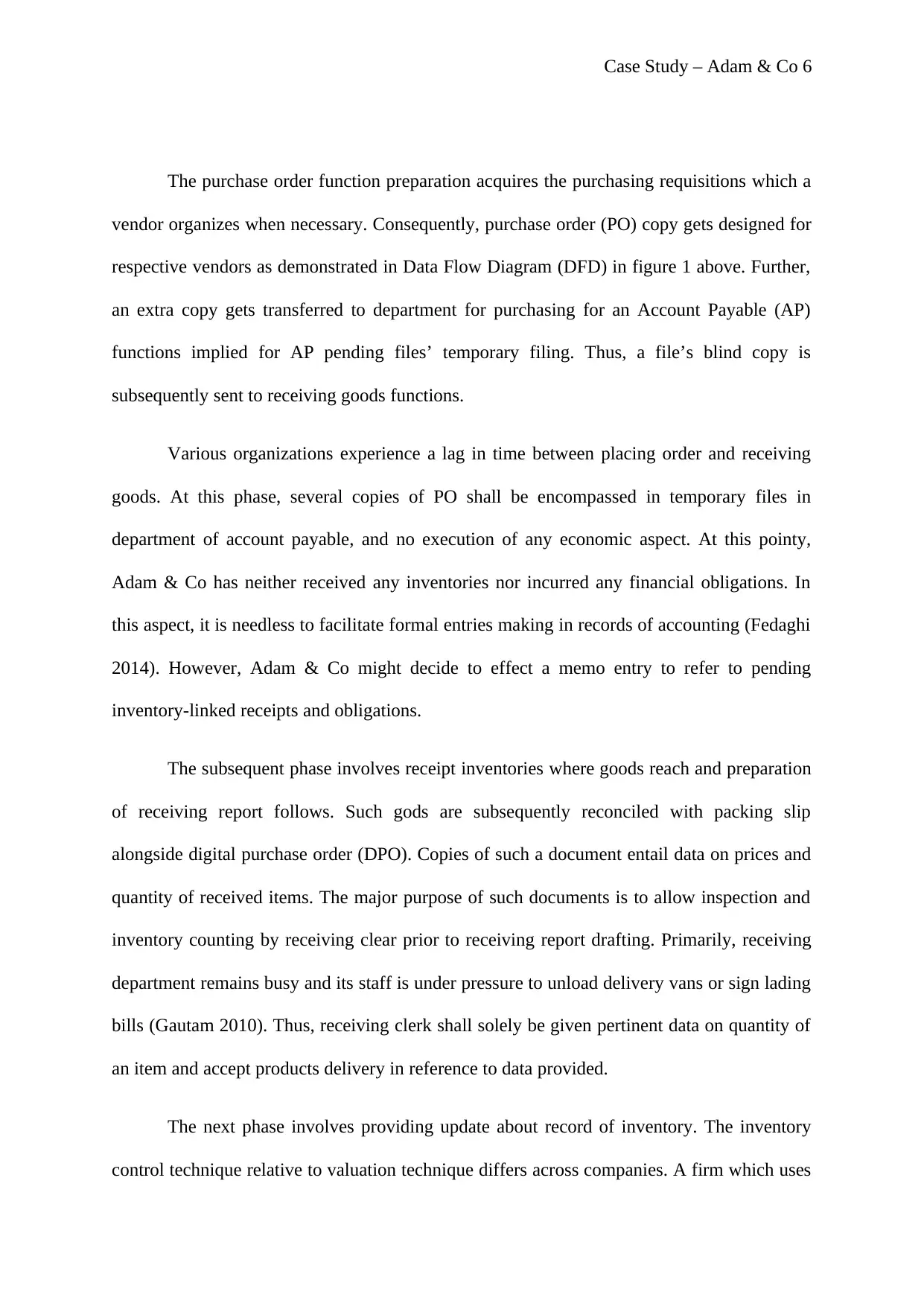
Case Study – Adam & Co 6
The purchase order function preparation acquires the purchasing requisitions which a
vendor organizes when necessary. Consequently, purchase order (PO) copy gets designed for
respective vendors as demonstrated in Data Flow Diagram (DFD) in figure 1 above. Further,
an extra copy gets transferred to department for purchasing for an Account Payable (AP)
functions implied for AP pending files’ temporary filing. Thus, a file’s blind copy is
subsequently sent to receiving goods functions.
Various organizations experience a lag in time between placing order and receiving
goods. At this phase, several copies of PO shall be encompassed in temporary files in
department of account payable, and no execution of any economic aspect. At this pointy,
Adam & Co has neither received any inventories nor incurred any financial obligations. In
this aspect, it is needless to facilitate formal entries making in records of accounting (Fedaghi
2014). However, Adam & Co might decide to effect a memo entry to refer to pending
inventory-linked receipts and obligations.
The subsequent phase involves receipt inventories where goods reach and preparation
of receiving report follows. Such gods are subsequently reconciled with packing slip
alongside digital purchase order (DPO). Copies of such a document entail data on prices and
quantity of received items. The major purpose of such documents is to allow inspection and
inventory counting by receiving clear prior to receiving report drafting. Primarily, receiving
department remains busy and its staff is under pressure to unload delivery vans or sign lading
bills (Gautam 2010). Thus, receiving clerk shall solely be given pertinent data on quantity of
an item and accept products delivery in reference to data provided.
The next phase involves providing update about record of inventory. The inventory
control technique relative to valuation technique differs across companies. A firm which uses
The purchase order function preparation acquires the purchasing requisitions which a
vendor organizes when necessary. Consequently, purchase order (PO) copy gets designed for
respective vendors as demonstrated in Data Flow Diagram (DFD) in figure 1 above. Further,
an extra copy gets transferred to department for purchasing for an Account Payable (AP)
functions implied for AP pending files’ temporary filing. Thus, a file’s blind copy is
subsequently sent to receiving goods functions.
Various organizations experience a lag in time between placing order and receiving
goods. At this phase, several copies of PO shall be encompassed in temporary files in
department of account payable, and no execution of any economic aspect. At this pointy,
Adam & Co has neither received any inventories nor incurred any financial obligations. In
this aspect, it is needless to facilitate formal entries making in records of accounting (Fedaghi
2014). However, Adam & Co might decide to effect a memo entry to refer to pending
inventory-linked receipts and obligations.
The subsequent phase involves receipt inventories where goods reach and preparation
of receiving report follows. Such gods are subsequently reconciled with packing slip
alongside digital purchase order (DPO). Copies of such a document entail data on prices and
quantity of received items. The major purpose of such documents is to allow inspection and
inventory counting by receiving clear prior to receiving report drafting. Primarily, receiving
department remains busy and its staff is under pressure to unload delivery vans or sign lading
bills (Gautam 2010). Thus, receiving clerk shall solely be given pertinent data on quantity of
an item and accept products delivery in reference to data provided.
The next phase involves providing update about record of inventory. The inventory
control technique relative to valuation technique differs across companies. A firm which uses
⊘ This is a preview!⊘
Do you want full access?
Subscribe today to unlock all pages.

Trusted by 1+ million students worldwide
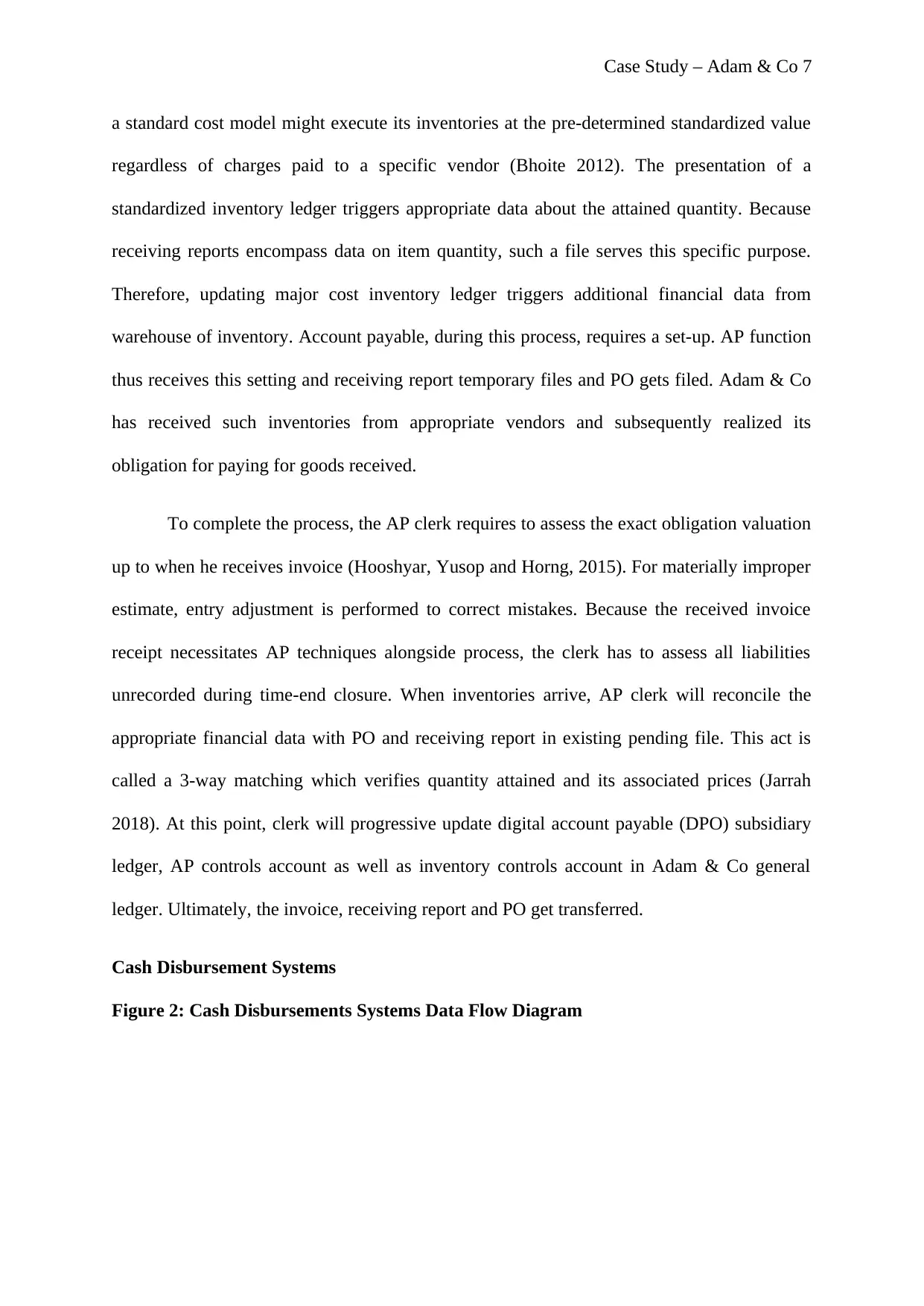
Case Study – Adam & Co 7
a standard cost model might execute its inventories at the pre-determined standardized value
regardless of charges paid to a specific vendor (Bhoite 2012). The presentation of a
standardized inventory ledger triggers appropriate data about the attained quantity. Because
receiving reports encompass data on item quantity, such a file serves this specific purpose.
Therefore, updating major cost inventory ledger triggers additional financial data from
warehouse of inventory. Account payable, during this process, requires a set-up. AP function
thus receives this setting and receiving report temporary files and PO gets filed. Adam & Co
has received such inventories from appropriate vendors and subsequently realized its
obligation for paying for goods received.
To complete the process, the AP clerk requires to assess the exact obligation valuation
up to when he receives invoice (Hooshyar, Yusop and Horng, 2015). For materially improper
estimate, entry adjustment is performed to correct mistakes. Because the received invoice
receipt necessitates AP techniques alongside process, the clerk has to assess all liabilities
unrecorded during time-end closure. When inventories arrive, AP clerk will reconcile the
appropriate financial data with PO and receiving report in existing pending file. This act is
called a 3-way matching which verifies quantity attained and its associated prices (Jarrah
2018). At this point, clerk will progressive update digital account payable (DPO) subsidiary
ledger, AP controls account as well as inventory controls account in Adam & Co general
ledger. Ultimately, the invoice, receiving report and PO get transferred.
Cash Disbursement Systems
Figure 2: Cash Disbursements Systems Data Flow Diagram
a standard cost model might execute its inventories at the pre-determined standardized value
regardless of charges paid to a specific vendor (Bhoite 2012). The presentation of a
standardized inventory ledger triggers appropriate data about the attained quantity. Because
receiving reports encompass data on item quantity, such a file serves this specific purpose.
Therefore, updating major cost inventory ledger triggers additional financial data from
warehouse of inventory. Account payable, during this process, requires a set-up. AP function
thus receives this setting and receiving report temporary files and PO gets filed. Adam & Co
has received such inventories from appropriate vendors and subsequently realized its
obligation for paying for goods received.
To complete the process, the AP clerk requires to assess the exact obligation valuation
up to when he receives invoice (Hooshyar, Yusop and Horng, 2015). For materially improper
estimate, entry adjustment is performed to correct mistakes. Because the received invoice
receipt necessitates AP techniques alongside process, the clerk has to assess all liabilities
unrecorded during time-end closure. When inventories arrive, AP clerk will reconcile the
appropriate financial data with PO and receiving report in existing pending file. This act is
called a 3-way matching which verifies quantity attained and its associated prices (Jarrah
2018). At this point, clerk will progressive update digital account payable (DPO) subsidiary
ledger, AP controls account as well as inventory controls account in Adam & Co general
ledger. Ultimately, the invoice, receiving report and PO get transferred.
Cash Disbursement Systems
Figure 2: Cash Disbursements Systems Data Flow Diagram
Paraphrase This Document
Need a fresh take? Get an instant paraphrase of this document with our AI Paraphraser
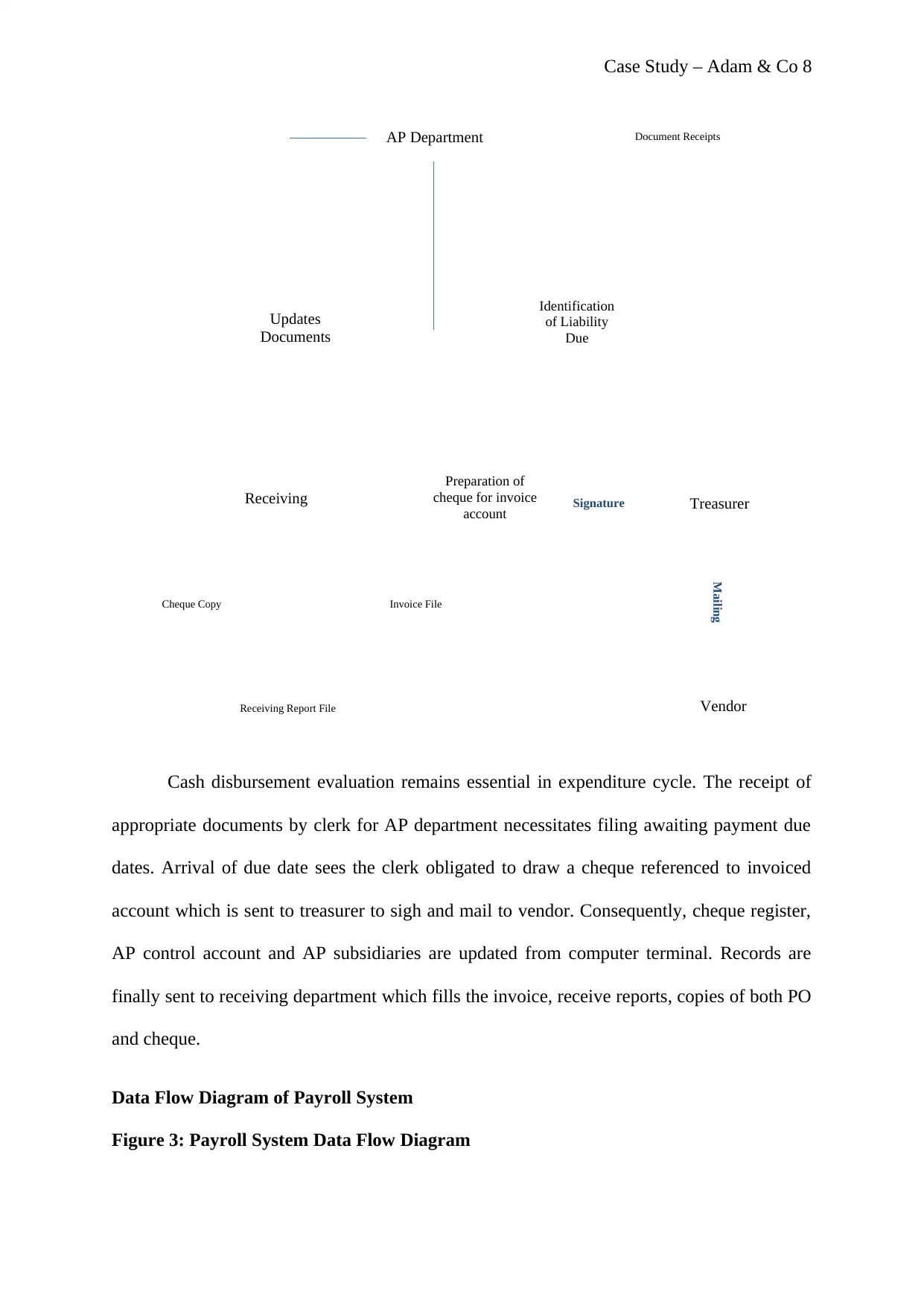
AP Department
Updates
Documents
Document Receipts
Identification
of Liability
Due
Treasurer
Vendor
Preparation of
cheque for invoice
account Signature
Mailing
Receiving
Receiving Report File
Invoice FileCheque Copy
Case Study – Adam & Co 8
Cash disbursement evaluation remains essential in expenditure cycle. The receipt of
appropriate documents by clerk for AP department necessitates filing awaiting payment due
dates. Arrival of due date sees the clerk obligated to draw a cheque referenced to invoiced
account which is sent to treasurer to sigh and mail to vendor. Consequently, cheque register,
AP control account and AP subsidiaries are updated from computer terminal. Records are
finally sent to receiving department which fills the invoice, receive reports, copies of both PO
and cheque.
Data Flow Diagram of Payroll System
Figure 3: Payroll System Data Flow Diagram
Updates
Documents
Document Receipts
Identification
of Liability
Due
Treasurer
Vendor
Preparation of
cheque for invoice
account Signature
Mailing
Receiving
Receiving Report File
Invoice FileCheque Copy
Case Study – Adam & Co 8
Cash disbursement evaluation remains essential in expenditure cycle. The receipt of
appropriate documents by clerk for AP department necessitates filing awaiting payment due
dates. Arrival of due date sees the clerk obligated to draw a cheque referenced to invoiced
account which is sent to treasurer to sigh and mail to vendor. Consequently, cheque register,
AP control account and AP subsidiaries are updated from computer terminal. Records are
finally sent to receiving department which fills the invoice, receive reports, copies of both PO
and cheque.
Data Flow Diagram of Payroll System
Figure 3: Payroll System Data Flow Diagram
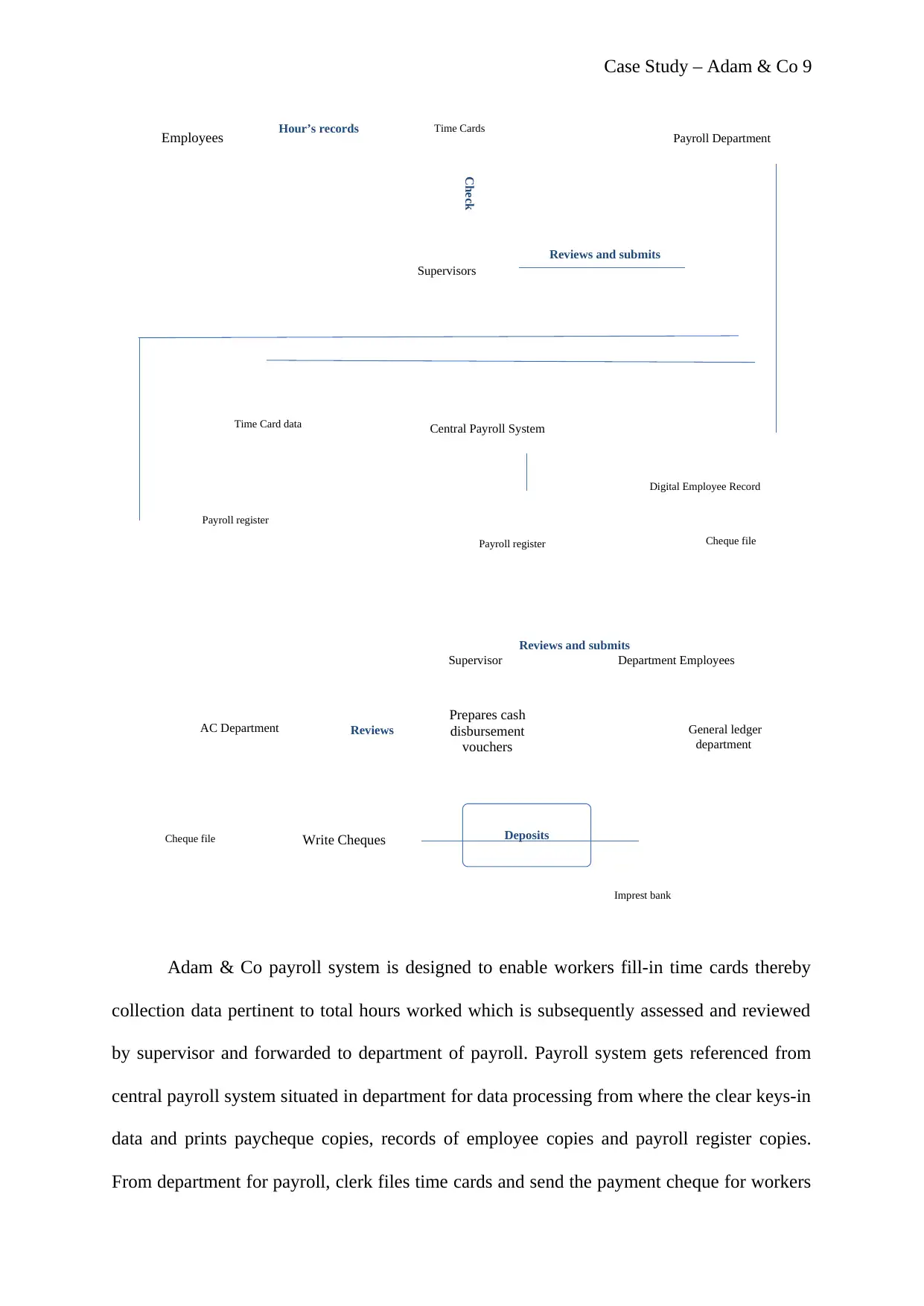
Prepares cash
disbursement
vouchers
Payroll DepartmentEmployees Time Cards
Supervisors
Central Payroll SystemTime Card data
Payroll register
Payroll register
Supervisor
AC Department
Write ChequesCheque file
Imprest bank
General ledger
department
Cheque file
Department Employees
Reviews and submits
Hour’s records
Digital Employee Record
Reviews and submits
Deposits
Reviews
Check
Case Study – Adam & Co 9
Adam & Co payroll system is designed to enable workers fill-in time cards thereby
collection data pertinent to total hours worked which is subsequently assessed and reviewed
by supervisor and forwarded to department of payroll. Payroll system gets referenced from
central payroll system situated in department for data processing from where the clear keys-in
data and prints paycheque copies, records of employee copies and payroll register copies.
From department for payroll, clerk files time cards and send the payment cheque for workers
disbursement
vouchers
Payroll DepartmentEmployees Time Cards
Supervisors
Central Payroll SystemTime Card data
Payroll register
Payroll register
Supervisor
AC Department
Write ChequesCheque file
Imprest bank
General ledger
department
Cheque file
Department Employees
Reviews and submits
Hour’s records
Digital Employee Record
Reviews and submits
Deposits
Reviews
Check
Case Study – Adam & Co 9
Adam & Co payroll system is designed to enable workers fill-in time cards thereby
collection data pertinent to total hours worked which is subsequently assessed and reviewed
by supervisor and forwarded to department of payroll. Payroll system gets referenced from
central payroll system situated in department for data processing from where the clear keys-in
data and prints paycheque copies, records of employee copies and payroll register copies.
From department for payroll, clerk files time cards and send the payment cheque for workers
⊘ This is a preview!⊘
Do you want full access?
Subscribe today to unlock all pages.

Trusted by 1+ million students worldwide
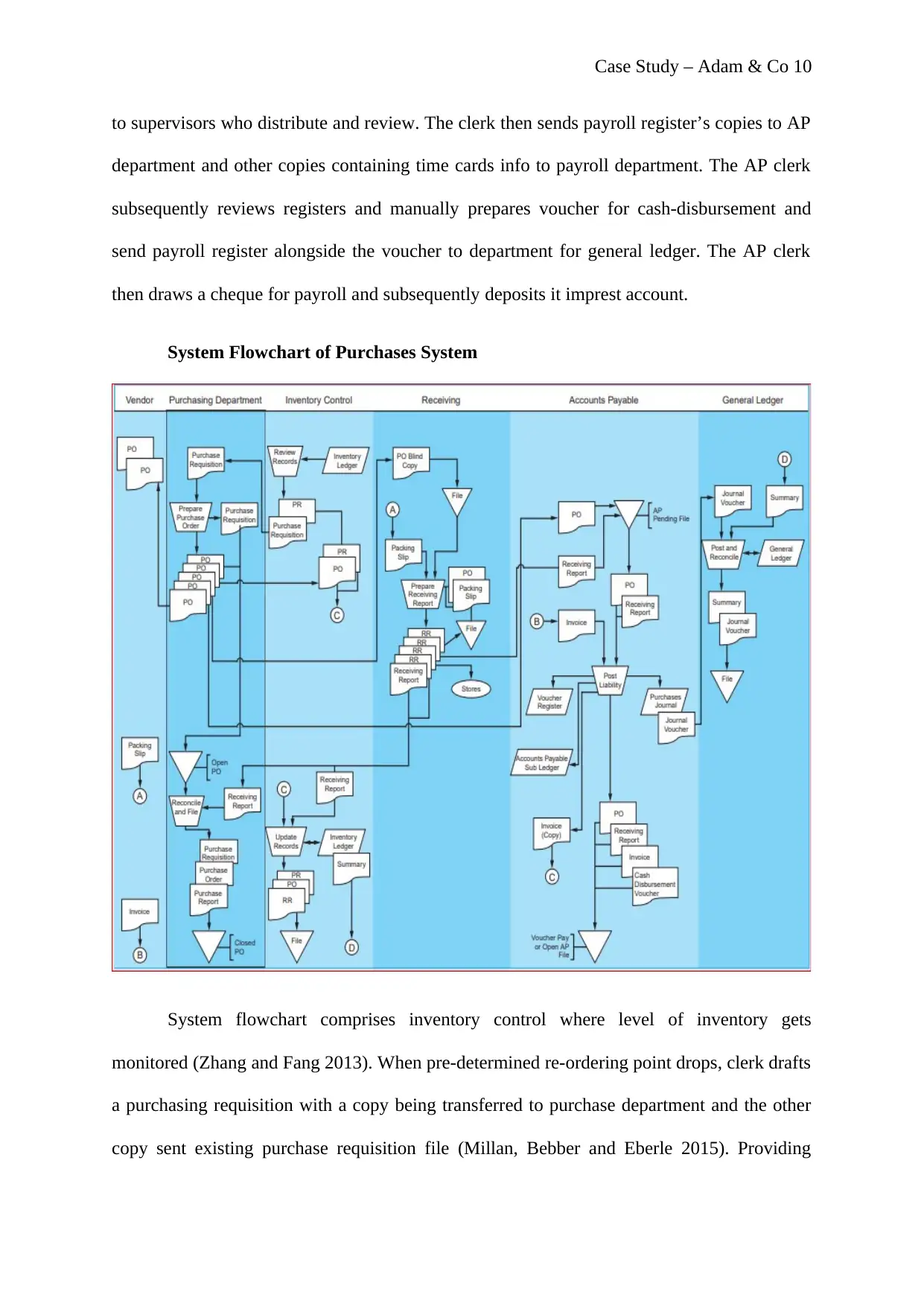
Case Study – Adam & Co 10
to supervisors who distribute and review. The clerk then sends payroll register’s copies to AP
department and other copies containing time cards info to payroll department. The AP clerk
subsequently reviews registers and manually prepares voucher for cash-disbursement and
send payroll register alongside the voucher to department for general ledger. The AP clerk
then draws a cheque for payroll and subsequently deposits it imprest account.
System Flowchart of Purchases System
System flowchart comprises inventory control where level of inventory gets
monitored (Zhang and Fang 2013). When pre-determined re-ordering point drops, clerk drafts
a purchasing requisition with a copy being transferred to purchase department and the other
copy sent existing purchase requisition file (Millan, Bebber and Eberle 2015). Providing
to supervisors who distribute and review. The clerk then sends payroll register’s copies to AP
department and other copies containing time cards info to payroll department. The AP clerk
subsequently reviews registers and manually prepares voucher for cash-disbursement and
send payroll register alongside the voucher to department for general ledger. The AP clerk
then draws a cheque for payroll and subsequently deposits it imprest account.
System Flowchart of Purchases System
System flowchart comprises inventory control where level of inventory gets
monitored (Zhang and Fang 2013). When pre-determined re-ordering point drops, clerk drafts
a purchasing requisition with a copy being transferred to purchase department and the other
copy sent existing purchase requisition file (Millan, Bebber and Eberle 2015). Providing
Paraphrase This Document
Need a fresh take? Get an instant paraphrase of this document with our AI Paraphraser

Case Study – Adam & Co 11
authorization control in inventories control department is distinguished from purchase
department which executes transactions.
The process proceeds purchase requisition, vendor’s sorting and PO preparation for
each vendor in purchasing department. At this point, two purchase order copies get
transferred to a vendor and copy of PO is sent to inventory control to be filed alongside
purchasing requisition available. Goods arising from vendors are subsequently reconciled
with PO’s blind copies. At the completion of the process of physical filing and inspection,
receiving clerk subsequently makes different reports stating the quantity and condition of
inventories (Nakamoto 2017). A copy of receiving reports is then sent to inventory
department alongside physical inventory whereas the other copy is sent to purchase
department where the clerk can reconcile it with existing PO.
In the department for AP, clerk received the incoming invoice where info get
reconciled with existing pending doc file. Afterwards, the relevant transaction is recorded in
journal purchase and points which include AP subsidiary ledger’s preparation. This proceeds
liabilities record where a clerk transfers source doc, receiving reports alongside existing
voucher payable files. At this point, the digital account payable subsidiary ledgers’ update is
performed, which include AP control account alongside inventories control from computer
terminal in general ledger department. Finally, the invoices, receiving reports alongside PO
copies are transferred to department of cash disbursement by the clerk.
authorization control in inventories control department is distinguished from purchase
department which executes transactions.
The process proceeds purchase requisition, vendor’s sorting and PO preparation for
each vendor in purchasing department. At this point, two purchase order copies get
transferred to a vendor and copy of PO is sent to inventory control to be filed alongside
purchasing requisition available. Goods arising from vendors are subsequently reconciled
with PO’s blind copies. At the completion of the process of physical filing and inspection,
receiving clerk subsequently makes different reports stating the quantity and condition of
inventories (Nakamoto 2017). A copy of receiving reports is then sent to inventory
department alongside physical inventory whereas the other copy is sent to purchase
department where the clerk can reconcile it with existing PO.
In the department for AP, clerk received the incoming invoice where info get
reconciled with existing pending doc file. Afterwards, the relevant transaction is recorded in
journal purchase and points which include AP subsidiary ledger’s preparation. This proceeds
liabilities record where a clerk transfers source doc, receiving reports alongside existing
voucher payable files. At this point, the digital account payable subsidiary ledgers’ update is
performed, which include AP control account alongside inventories control from computer
terminal in general ledger department. Finally, the invoices, receiving reports alongside PO
copies are transferred to department of cash disbursement by the clerk.
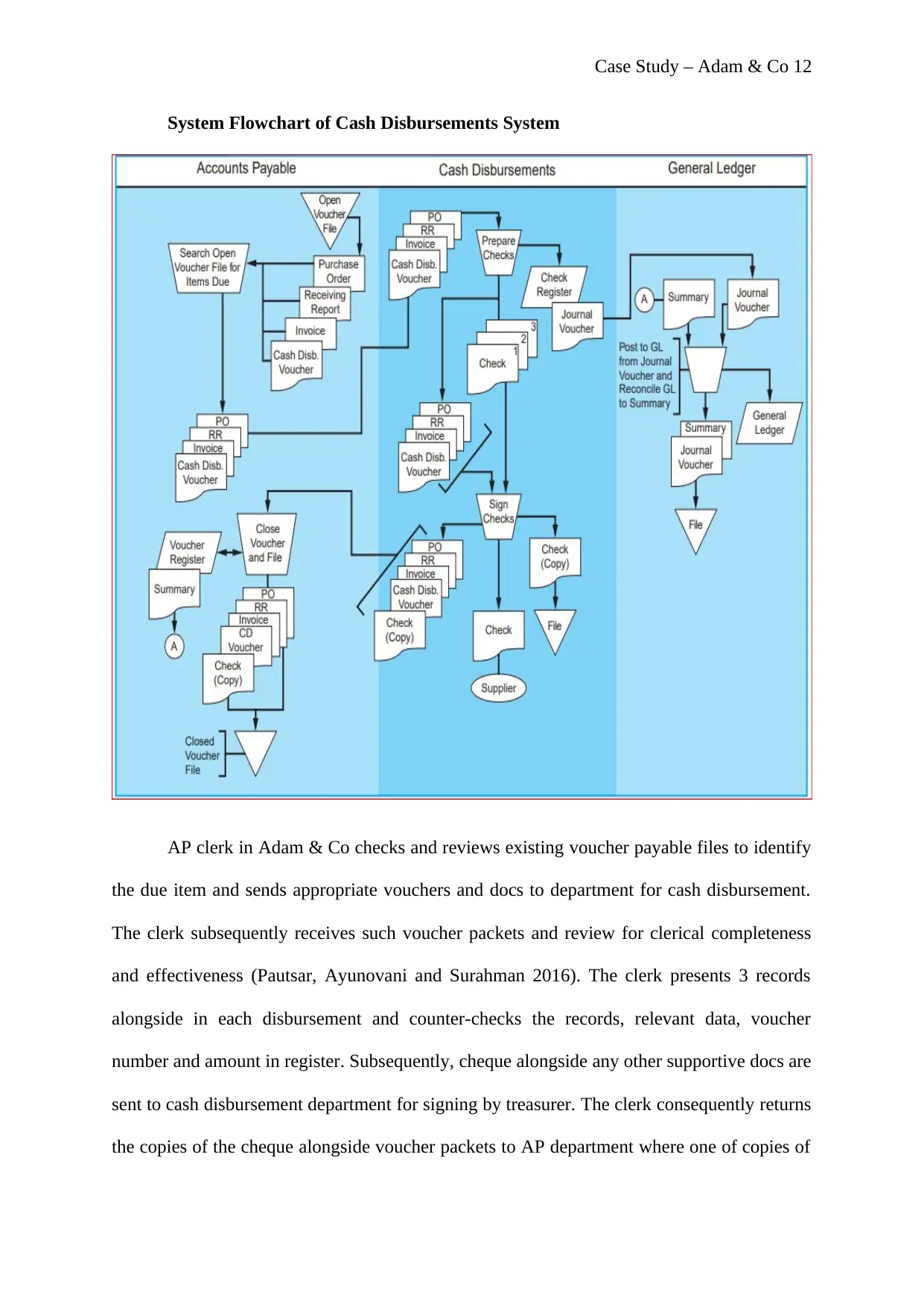
Case Study – Adam & Co 12
System Flowchart of Cash Disbursements System
AP clerk in Adam & Co checks and reviews existing voucher payable files to identify
the due item and sends appropriate vouchers and docs to department for cash disbursement.
The clerk subsequently receives such voucher packets and review for clerical completeness
and effectiveness (Pautsar, Ayunovani and Surahman 2016). The clerk presents 3 records
alongside in each disbursement and counter-checks the records, relevant data, voucher
number and amount in register. Subsequently, cheque alongside any other supportive docs are
sent to cash disbursement department for signing by treasurer. The clerk consequently returns
the copies of the cheque alongside voucher packets to AP department where one of copies of
System Flowchart of Cash Disbursements System
AP clerk in Adam & Co checks and reviews existing voucher payable files to identify
the due item and sends appropriate vouchers and docs to department for cash disbursement.
The clerk subsequently receives such voucher packets and review for clerical completeness
and effectiveness (Pautsar, Ayunovani and Surahman 2016). The clerk presents 3 records
alongside in each disbursement and counter-checks the records, relevant data, voucher
number and amount in register. Subsequently, cheque alongside any other supportive docs are
sent to cash disbursement department for signing by treasurer. The clerk consequently returns
the copies of the cheque alongside voucher packets to AP department where one of copies of
⊘ This is a preview!⊘
Do you want full access?
Subscribe today to unlock all pages.

Trusted by 1+ million students worldwide
1 out of 17
Related Documents
Your All-in-One AI-Powered Toolkit for Academic Success.
+13062052269
info@desklib.com
Available 24*7 on WhatsApp / Email
![[object Object]](/_next/static/media/star-bottom.7253800d.svg)
Unlock your academic potential
Copyright © 2020–2025 A2Z Services. All Rights Reserved. Developed and managed by ZUCOL.





